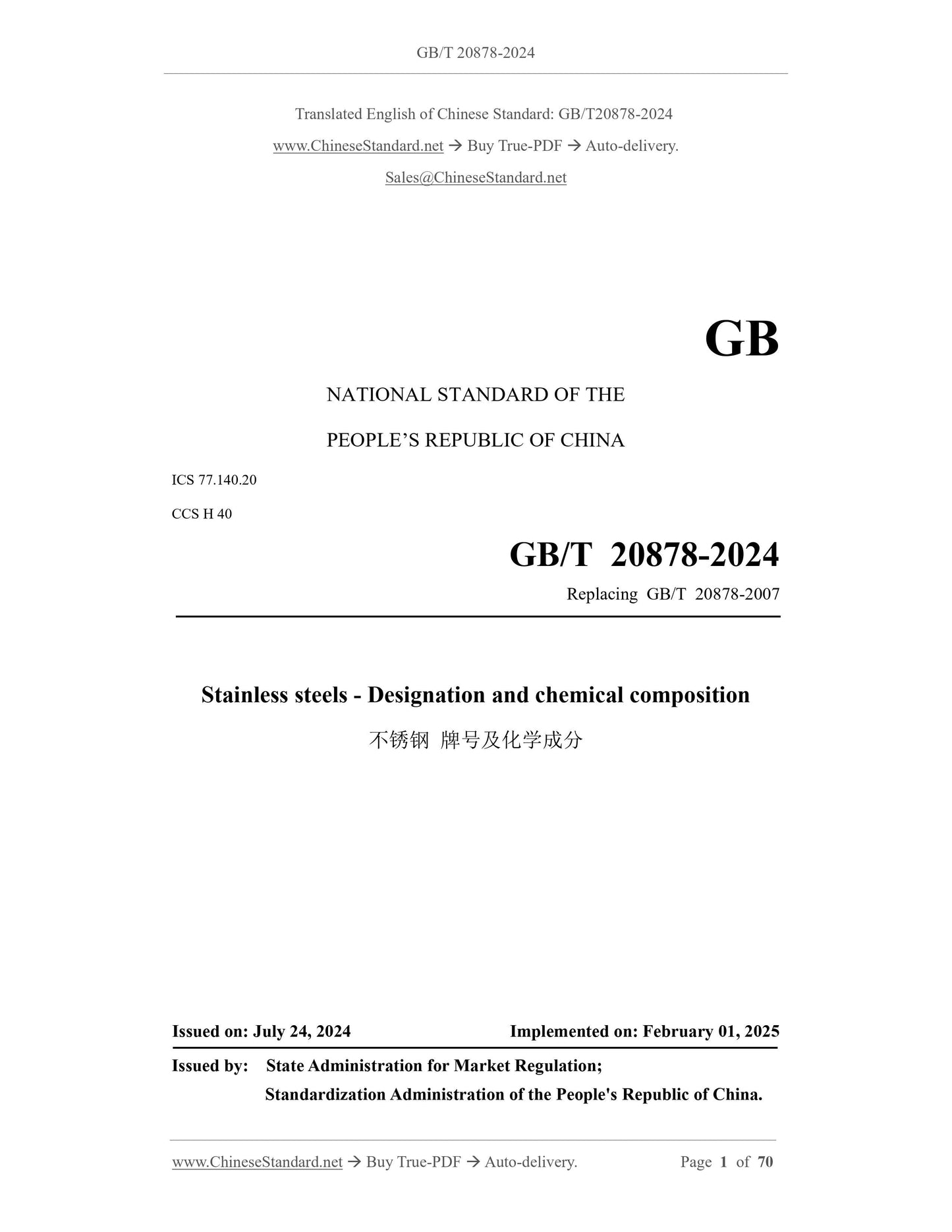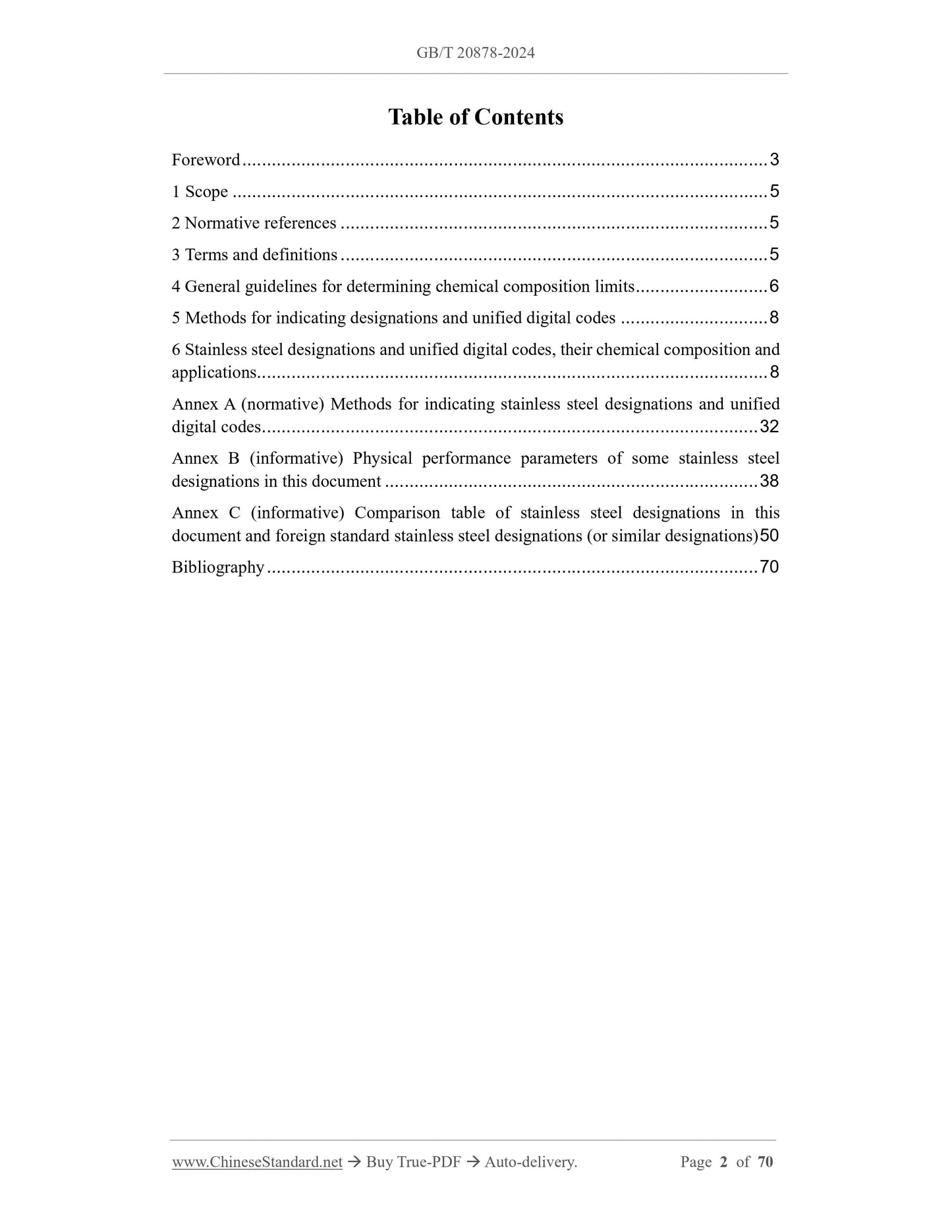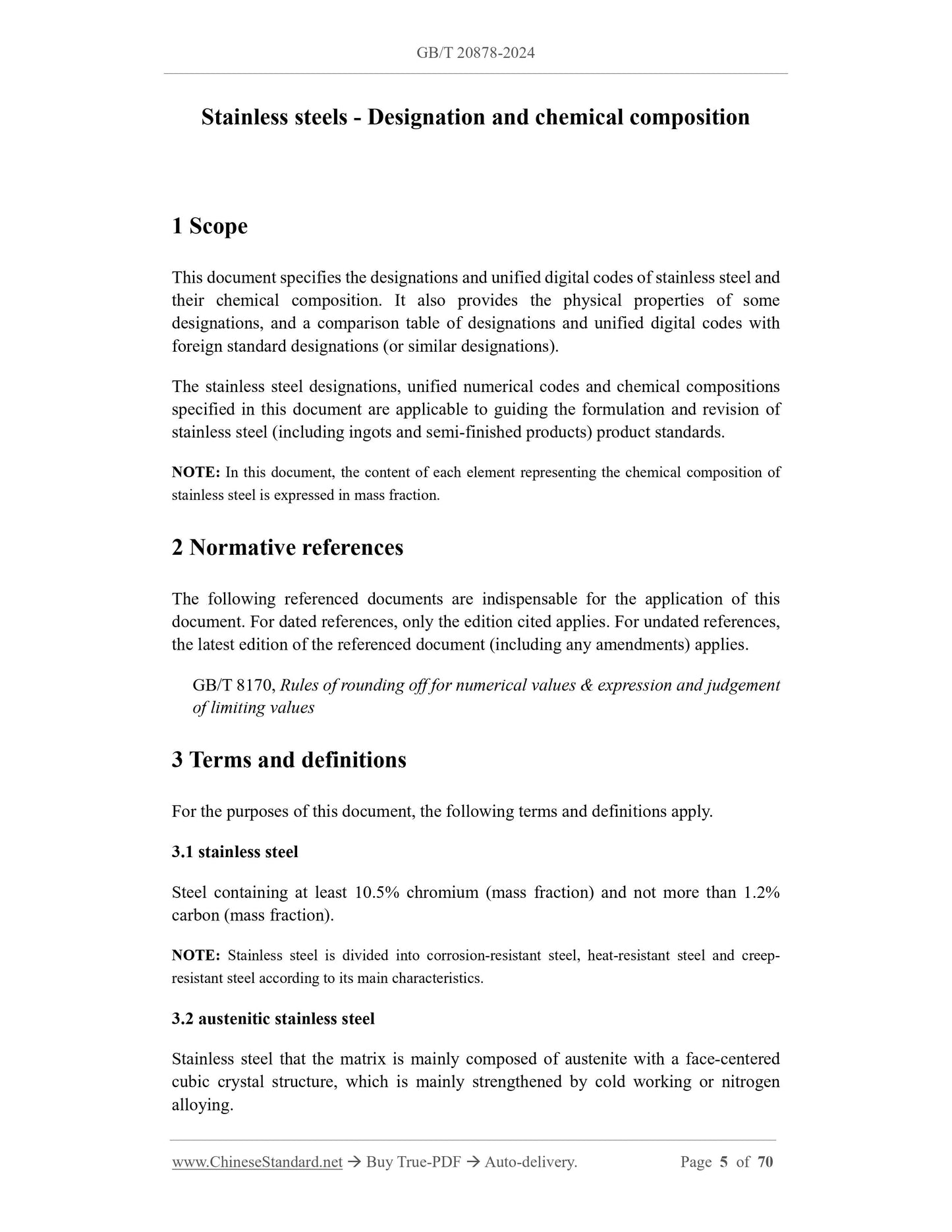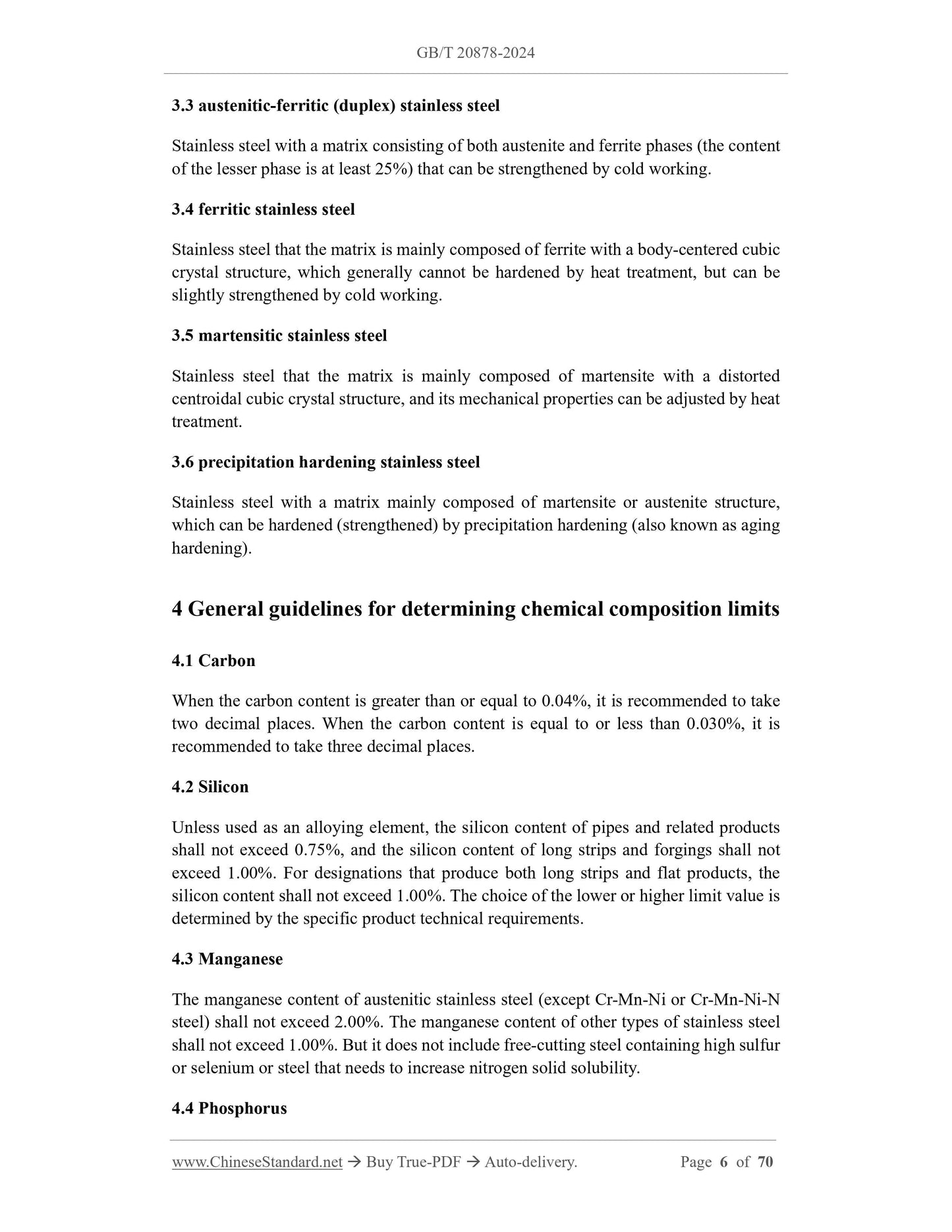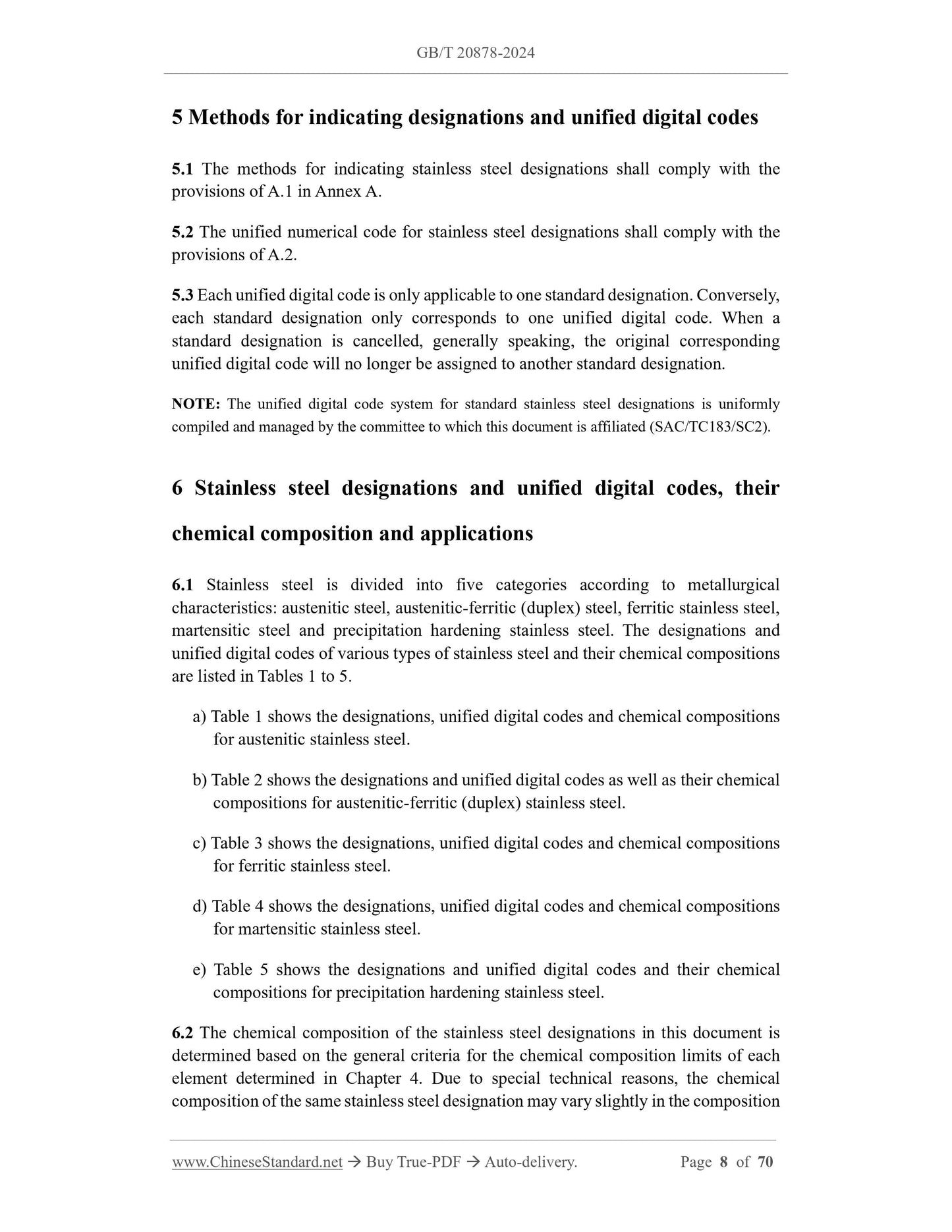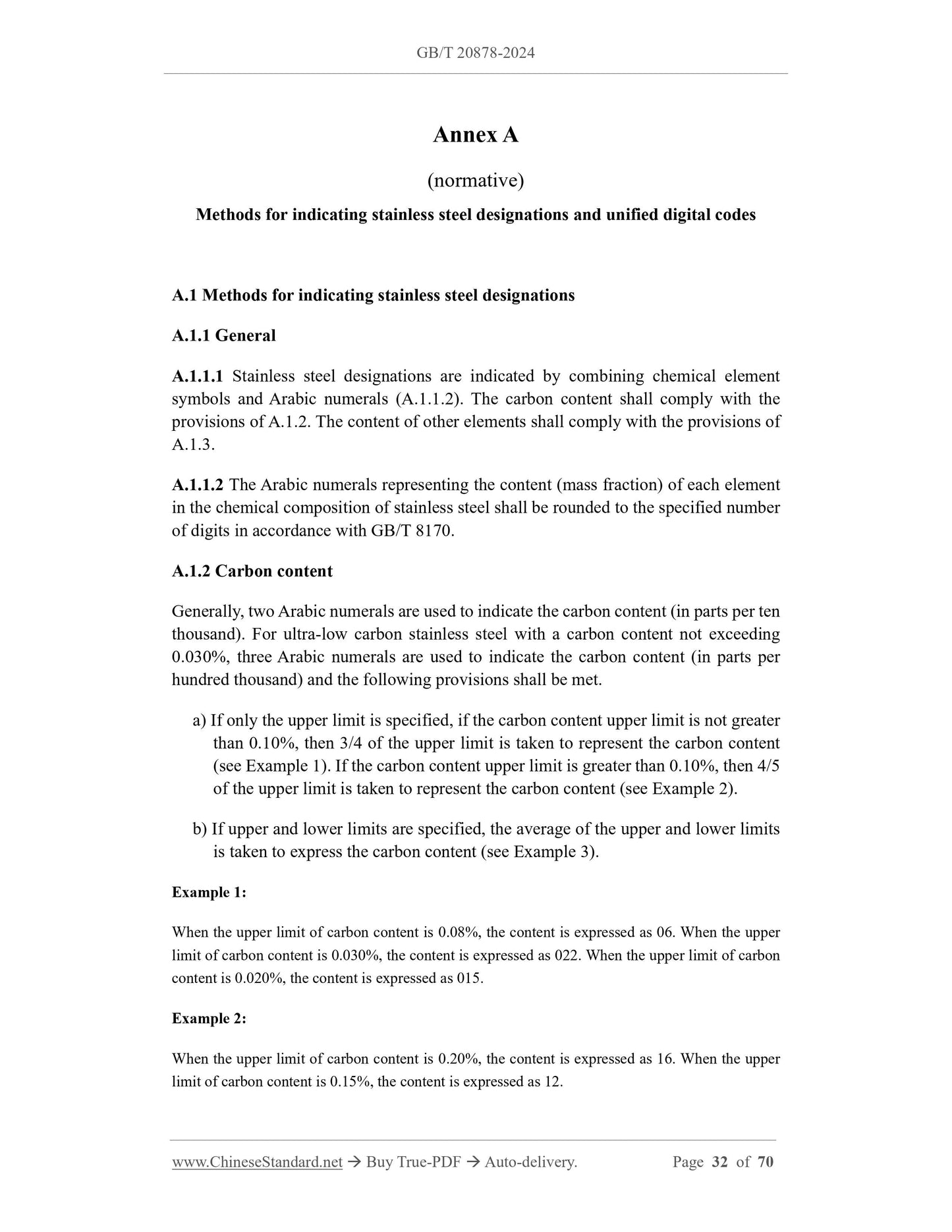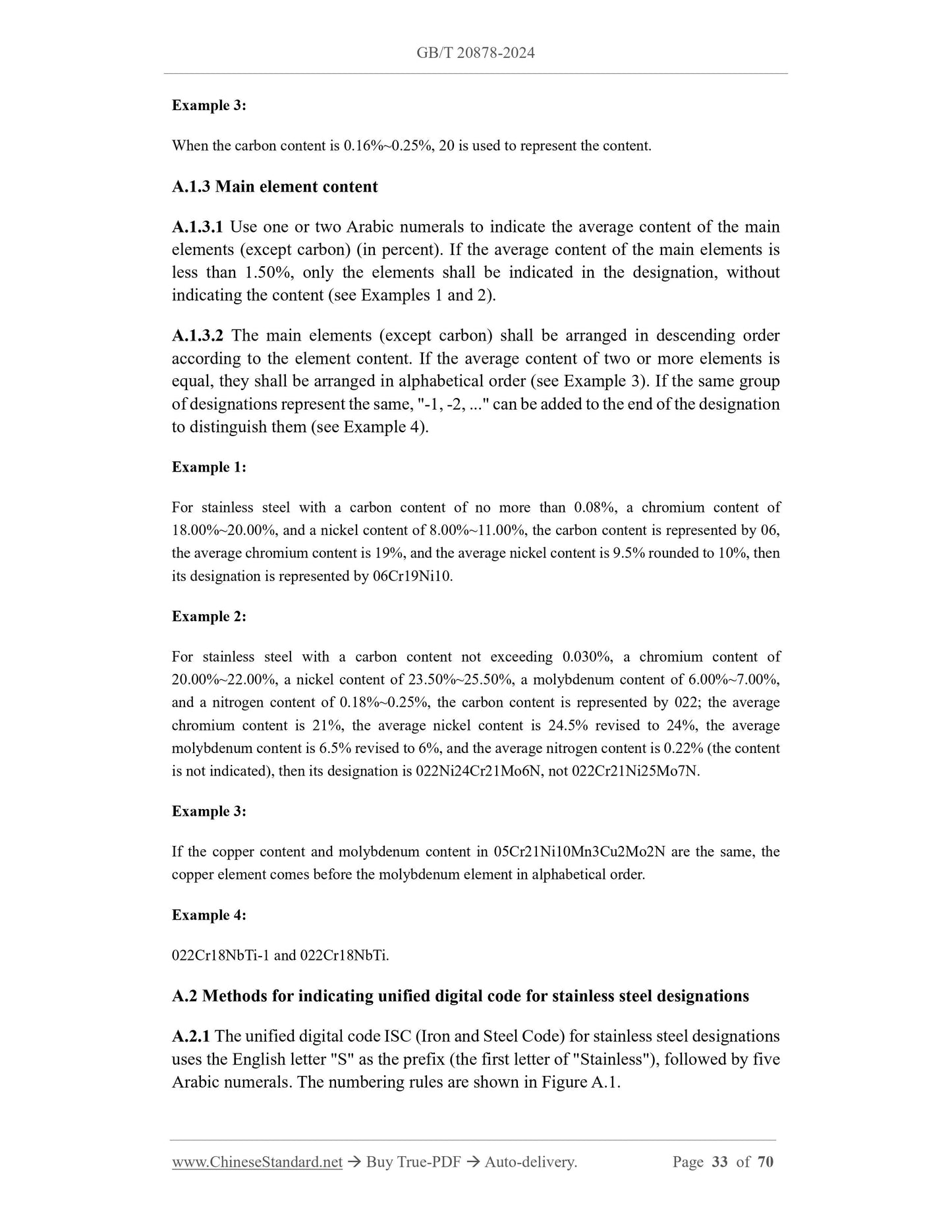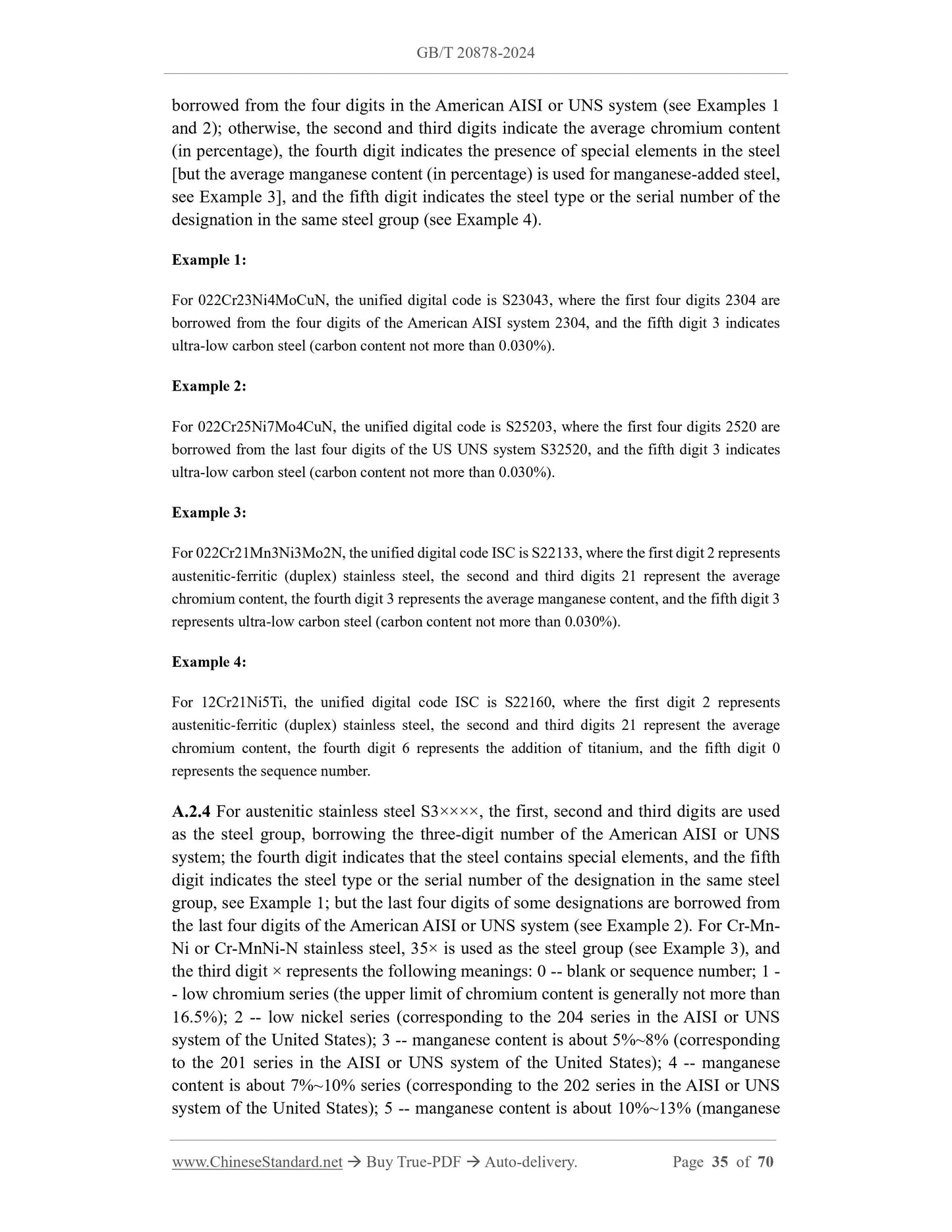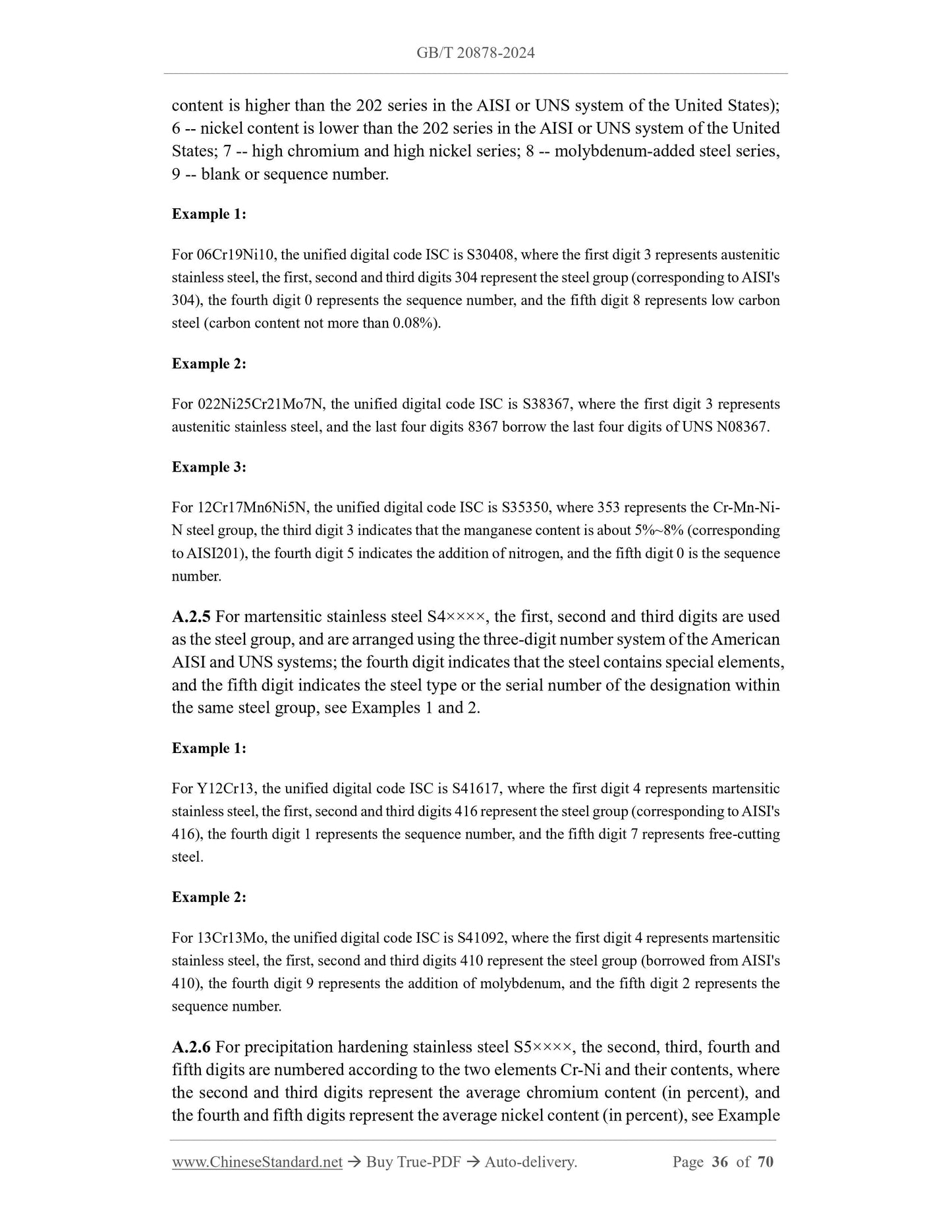1
/
of
9
Sales@ChineseStandard.net (Field Test Asia Pte. Ltd.)
GB/T 20878-2024 English PDF (GBT20878-2024)
GB/T 20878-2024 English PDF (GBT20878-2024)
Regular price
$595.00 USD
Regular price
Sale price
$595.00 USD
Unit price
/
per
Shipping calculated at checkout.
Couldn't load pickup availability
Delivery: 3 seconds. Download true-PDF + Invoice.
Get QUOTATION in 1-minute: Click GB/T 20878-2024
Historical versions: GB/T 20878-2024
Preview True-PDF (Reload/Scroll if blank)
GB/T 20878-2024: Stainless steels - Designation and chemical composition
GB/T 20878-2024
GB
NATIONAL STANDARD OF THE
PEOPLE’S REPUBLIC OF CHINA
ICS 77.140.20
CCS H 40
Replacing GB/T 20878-2007
Stainless steels - Designation and chemical composition
ISSUED ON: JULY 24, 2024
IMPLEMENTED ON: FEBRUARY 01, 2025
Issued by: State Administration for Market Regulation;
Standardization Administration of the People's Republic of China.
Table of Contents
Foreword ... 3
1 Scope ... 5
2 Normative references ... 5
3 Terms and definitions ... 5
4 General guidelines for determining chemical composition limits ... 6
5 Methods for indicating designations and unified digital codes ... 8
6 Stainless steel designations and unified digital codes, their chemical composition and
applications... 8
Annex A (normative) Methods for indicating stainless steel designations and unified
digital codes ... 32
Annex B (informative) Physical performance parameters of some stainless steel
designations in this document ... 38
Annex C (informative) Comparison table of stainless steel designations in this
document and foreign standard stainless steel designations (or similar designations) 50
Bibliography ... 70
Stainless steels - Designation and chemical composition
1 Scope
This document specifies the designations and unified digital codes of stainless steel and
their chemical composition. It also provides the physical properties of some
designations, and a comparison table of designations and unified digital codes with
foreign standard designations (or similar designations).
The stainless steel designations, unified numerical codes and chemical compositions
specified in this document are applicable to guiding the formulation and revision of
stainless steel (including ingots and semi-finished products) product standards.
NOTE: In this document, the content of each element representing the chemical composition of
stainless steel is expressed in mass fraction.
2 Normative references
The following referenced documents are indispensable for the application of this
document. For dated references, only the edition cited applies. For undated references,
the latest edition of the referenced document (including any amendments) applies.
GB/T 8170, Rules of rounding off for numerical values and expression and judgement
of limiting values
3 Terms and definitions
For the purposes of this document, the following terms and definitions apply.
3.1 stainless steel
Steel containing at least 10.5% chromium (mass fraction) and not more than 1.2%
carbon (mass fraction).
NOTE: Stainless steel is divided into corrosion-resistant steel, heat-resistant steel and creep-
resistant steel according to its main characteristics.
3.2 austenitic stainless steel
Stainless steel that the matrix is mainly composed of austenite with a face-centered
cubic crystal structure, which is mainly strengthened by cold working or nitrogen
alloying.
3.3 austenitic-ferritic (duplex) stainless steel
Stainless steel with a matrix consisting of both austenite and ferrite phases (the content
of the lesser phase is at least 25%) that can be strengthened by cold working.
3.4 ferritic stainless steel
Stainless steel that the matrix is mainly composed of ferrite with a body-centered cubic
crystal structure, which generally cannot be hardened by heat treatment, but can be
slightly strengthened by cold working.
3.5 martensitic stainless steel
Stainless steel that the matrix is mainly composed of martensite with a distorted
centroidal cubic crystal structure, and its mechanical properties can be adjusted by heat
treatment.
3.6 precipitation hardening stainless steel
Stainless steel with a matrix mainly composed of martensite or austenite structure,
which can be hardened (strengthened) by precipitation hardening (also known as aging
hardening).
4 General guidelines for determining chemical composition limits
4.1 Carbon
When the carbon content is greater than or equal to 0.04%, it is recommended to take
two decimal places. When the carbon content is equal to or less than 0.030%, it is
recommended to take three decimal places.
4.2 Silicon
Unless used as an alloying element, the silicon content of pipes and related products
shall not exceed 0.75%, and the silicon content of long strips and forgings shall not
exceed 1.00%. For designations that produce both long strips and flat products, the
silicon content shall not exceed 1.00%. The choice of the lower or higher limit value is
determined by the specific product technical requirements.
4.3 Manganese
The manganese content of austenitic stainless steel (except Cr-Mn-Ni or Cr-Mn-Ni-N
steel) shall not exceed 2.00%. The manganese content of other types of stainless steel
shall not exceed 1.00%. But it does not include free-cutting steel containing high sulfur
or selenium or steel that needs to increase nitrogen solid solubility.
4.4 Phosphorus
5 Methods for indicating designations and unified digital codes
5.1 The methods for indicating stainless steel designations shall comply with the
provisions of A.1 in Annex A.
5.2 The unified numerical code for stainless steel designations shall comply with the
provisions of A.2.
5.3 Each unified digital code is only applicable to one standard designation. Conversely,
each standard designation only corresponds to one unified digital code. When a
standard designation is cancelled, generally speaking, the original corresponding
unified digital code will no longer be assigned to another standard designation.
NOTE: The unified digital code system for standard stainless steel designations is uniformly
compiled and managed by the committee to which this document is affiliated (SAC/TC183/SC2).
6 Stainless steel designations and unified digital codes, their
chemical composition and applications
6.1 Stainless steel is divided into five categories according to metallurgical
characteristics: austenitic steel, austenitic-ferritic (duplex) steel, ferritic stainless steel,
martensitic steel and precipitation hardening stainless steel. The designations and
unified digital codes of various types of stainless steel and their chemical compositions
are listed in Tables 1 to 5.
a) Table 1 shows the designations, unified digital codes and chemical compositions
for austenitic stainless steel.
b) Table 2 shows the designations and unified digital codes as well as their chemical
compositions for austenitic-ferritic (duplex) stainless steel.
c) Table 3 shows the designations, unified digital codes and chemical compositions
for ferritic stainless steel.
d) Table 4 shows the designations, unified digital codes and chemical compositions
for martensitic stainless steel.
e) Table 5 shows the designations and unified digital codes and their chemical
compositions for precipitation hardening stainless steel.
6.2 The chemical composition of the stainless steel designations in this document is
determined based on the general criteria for the chemical composition limits of each
element determined in Chapter 4. Due to special technical reasons, the chemical
composition of the same stainless steel designation may vary slightly in the composition
Annex A
(normative)
Methods for indicating stainless steel designations and unified digital codes
A.1 Methods for indicating stainless steel designations
A.1.1 General
A.1.1.1 Stainless steel designations are indicated by combining chemical element
symbols and Arabic numerals (A.1.1.2). The carbon content shall comply w...
Get QUOTATION in 1-minute: Click GB/T 20878-2024
Historical versions: GB/T 20878-2024
Preview True-PDF (Reload/Scroll if blank)
GB/T 20878-2024: Stainless steels - Designation and chemical composition
GB/T 20878-2024
GB
NATIONAL STANDARD OF THE
PEOPLE’S REPUBLIC OF CHINA
ICS 77.140.20
CCS H 40
Replacing GB/T 20878-2007
Stainless steels - Designation and chemical composition
ISSUED ON: JULY 24, 2024
IMPLEMENTED ON: FEBRUARY 01, 2025
Issued by: State Administration for Market Regulation;
Standardization Administration of the People's Republic of China.
Table of Contents
Foreword ... 3
1 Scope ... 5
2 Normative references ... 5
3 Terms and definitions ... 5
4 General guidelines for determining chemical composition limits ... 6
5 Methods for indicating designations and unified digital codes ... 8
6 Stainless steel designations and unified digital codes, their chemical composition and
applications... 8
Annex A (normative) Methods for indicating stainless steel designations and unified
digital codes ... 32
Annex B (informative) Physical performance parameters of some stainless steel
designations in this document ... 38
Annex C (informative) Comparison table of stainless steel designations in this
document and foreign standard stainless steel designations (or similar designations) 50
Bibliography ... 70
Stainless steels - Designation and chemical composition
1 Scope
This document specifies the designations and unified digital codes of stainless steel and
their chemical composition. It also provides the physical properties of some
designations, and a comparison table of designations and unified digital codes with
foreign standard designations (or similar designations).
The stainless steel designations, unified numerical codes and chemical compositions
specified in this document are applicable to guiding the formulation and revision of
stainless steel (including ingots and semi-finished products) product standards.
NOTE: In this document, the content of each element representing the chemical composition of
stainless steel is expressed in mass fraction.
2 Normative references
The following referenced documents are indispensable for the application of this
document. For dated references, only the edition cited applies. For undated references,
the latest edition of the referenced document (including any amendments) applies.
GB/T 8170, Rules of rounding off for numerical values and expression and judgement
of limiting values
3 Terms and definitions
For the purposes of this document, the following terms and definitions apply.
3.1 stainless steel
Steel containing at least 10.5% chromium (mass fraction) and not more than 1.2%
carbon (mass fraction).
NOTE: Stainless steel is divided into corrosion-resistant steel, heat-resistant steel and creep-
resistant steel according to its main characteristics.
3.2 austenitic stainless steel
Stainless steel that the matrix is mainly composed of austenite with a face-centered
cubic crystal structure, which is mainly strengthened by cold working or nitrogen
alloying.
3.3 austenitic-ferritic (duplex) stainless steel
Stainless steel with a matrix consisting of both austenite and ferrite phases (the content
of the lesser phase is at least 25%) that can be strengthened by cold working.
3.4 ferritic stainless steel
Stainless steel that the matrix is mainly composed of ferrite with a body-centered cubic
crystal structure, which generally cannot be hardened by heat treatment, but can be
slightly strengthened by cold working.
3.5 martensitic stainless steel
Stainless steel that the matrix is mainly composed of martensite with a distorted
centroidal cubic crystal structure, and its mechanical properties can be adjusted by heat
treatment.
3.6 precipitation hardening stainless steel
Stainless steel with a matrix mainly composed of martensite or austenite structure,
which can be hardened (strengthened) by precipitation hardening (also known as aging
hardening).
4 General guidelines for determining chemical composition limits
4.1 Carbon
When the carbon content is greater than or equal to 0.04%, it is recommended to take
two decimal places. When the carbon content is equal to or less than 0.030%, it is
recommended to take three decimal places.
4.2 Silicon
Unless used as an alloying element, the silicon content of pipes and related products
shall not exceed 0.75%, and the silicon content of long strips and forgings shall not
exceed 1.00%. For designations that produce both long strips and flat products, the
silicon content shall not exceed 1.00%. The choice of the lower or higher limit value is
determined by the specific product technical requirements.
4.3 Manganese
The manganese content of austenitic stainless steel (except Cr-Mn-Ni or Cr-Mn-Ni-N
steel) shall not exceed 2.00%. The manganese content of other types of stainless steel
shall not exceed 1.00%. But it does not include free-cutting steel containing high sulfur
or selenium or steel that needs to increase nitrogen solid solubility.
4.4 Phosphorus
5 Methods for indicating designations and unified digital codes
5.1 The methods for indicating stainless steel designations shall comply with the
provisions of A.1 in Annex A.
5.2 The unified numerical code for stainless steel designations shall comply with the
provisions of A.2.
5.3 Each unified digital code is only applicable to one standard designation. Conversely,
each standard designation only corresponds to one unified digital code. When a
standard designation is cancelled, generally speaking, the original corresponding
unified digital code will no longer be assigned to another standard designation.
NOTE: The unified digital code system for standard stainless steel designations is uniformly
compiled and managed by the committee to which this document is affiliated (SAC/TC183/SC2).
6 Stainless steel designations and unified digital codes, their
chemical composition and applications
6.1 Stainless steel is divided into five categories according to metallurgical
characteristics: austenitic steel, austenitic-ferritic (duplex) steel, ferritic stainless steel,
martensitic steel and precipitation hardening stainless steel. The designations and
unified digital codes of various types of stainless steel and their chemical compositions
are listed in Tables 1 to 5.
a) Table 1 shows the designations, unified digital codes and chemical compositions
for austenitic stainless steel.
b) Table 2 shows the designations and unified digital codes as well as their chemical
compositions for austenitic-ferritic (duplex) stainless steel.
c) Table 3 shows the designations, unified digital codes and chemical compositions
for ferritic stainless steel.
d) Table 4 shows the designations, unified digital codes and chemical compositions
for martensitic stainless steel.
e) Table 5 shows the designations and unified digital codes and their chemical
compositions for precipitation hardening stainless steel.
6.2 The chemical composition of the stainless steel designations in this document is
determined based on the general criteria for the chemical composition limits of each
element determined in Chapter 4. Due to special technical reasons, the chemical
composition of the same stainless steel designation may vary slightly in the composition
Annex A
(normative)
Methods for indicating stainless steel designations and unified digital codes
A.1 Methods for indicating stainless steel designations
A.1.1 General
A.1.1.1 Stainless steel designations are indicated by combining chemical element
symbols and Arabic numerals (A.1.1.2). The carbon content shall comply w...
Share
